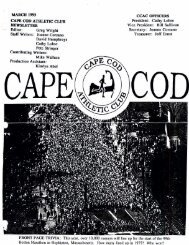One More Mile - Cape Cod Athletic Club
One More Mile - Cape Cod Athletic Club
One More Mile - Cape Cod Athletic Club
You also want an ePaper? Increase the reach of your titles
YUMPU automatically turns print PDFs into web optimized ePapers that Google loves.
<strong>Cape</strong> <strong>Cod</strong> <strong>Athletic</strong> <strong>Club</strong> - July/Oct 2007<br />
What is the marathon?<br />
The Multisport Wiki<br />
www.wikipedia.com<br />
T<br />
he marathon is a long-distance running event of 42.195 kilometres (26 miles 385 yards) that can be run either as a road<br />
race or off-road (for example, on mountain trails).<br />
History<br />
The name marathon comes from the legend of Pheidippides, a Greek soldier, who was sent from the town of Marathon to Athens<br />
to announce that the Persians had been defeated in the Battle of Marathon. It is said that he ran the entire distance without<br />
stopping and burst into the senate with the words "Masters! Victory is ours!" before collapsing and dying due to exhaustion. The<br />
account of the run from Marathon to Athens first appears in Plutarch's On the Glory of Athens in the 1st century AD who quotes<br />
from Heraclides Ponticus's lost work, giving the runner's name as either Thersipus of Erchius or Eucles. Lucian of Samosata<br />
(2nd century AD) also gives the story but names the runner Philippides (not Pheidippides).<br />
The Greek historian Herodotus, the main source for the Greco-Persian Wars, mentions Pheidippides as the messenger who ran<br />
from Athens to Sparta asking for help. In some Herodotus manuscripts the name of the runner between Athens and Sparta is<br />
given as Philippides. Herodotus makes no mention of a messenger sent from Marathon to Athens, and relates that the main part<br />
of the Athenian army, having already fought and won the grueling battle, and fearing a naval raid by the Persian fleet against an<br />
undefended Athens, marched quickly back from the battle to Athens, arriving the same day.<br />
There are two roads out of the battlefield of Marathon towards Athens, one more mountainous towards the north whose distance<br />
is about 34.5 km (21.4 miles), and another flatter but longer towards the south with a distance of 40.8 km (25.4 miles). It<br />
has been argued that the ancient runner took the more difficult northern road because at the time of the battle there were still<br />
Persian soldiers in the south of the plain.<br />
In 1876, Robert Browning wrote the poem "Pheidippides". Browning's poem, his composite story, became part of late 19th<br />
century popular culture and was accepted as an historic legend.<br />
When the idea of a modern Olympics became a reality at the end of the 19th century, the initiators and organizers were looking<br />
for a great popularizing event, recalling the ancient glory of Greece. The idea of organizing a marathon race came from Michel<br />
Bréal, who wanted the event to feature in the first modern Olympic Games in 1896 in Athens. This idea was heavily supported<br />
by Pierre de Coubertin, the founder of the modern Olympics, as well as the Greeks. The Greeks staged a selection race for the<br />
Olympic marathon, and this first marathon was won by Charilaos Vasilakos in 3 hours and 18 minutes (with the future winner<br />
of the introductory Olympic Games marathon coming in fifth). The winner of the first Olympic Marathon in 1896 (a male only<br />
race) was Spiridon "Spiros" Louis, a Greek water-carrier. He won at the Olympics in 2 hours 58 minutes and 50 seconds, despite<br />
stopping on the way for a glass of wine from his uncle waiting near the village of Chalandri.<br />
The women's marathon was introduced at the 1984 Summer Olympics (Los Angeles, USA).<br />
Distance<br />
The length of a marathon was not fixed at first, since the only important factor was that all athletes competed on the same<br />
course. The marathon races in the first few Olympic Games were not of a set length, but were approximately 40 km, roughly the<br />
distance from Marathon to Athens by the longer, flatter route. The exact length of the Olympic marathon varied depending on<br />
the route established for each venue.<br />
The marathon at the 1908 Summer Olympics in London was set to measure about 25 miles (40 km) and to start on ‘The Long<br />
Walk’ – a magnificent avenue leading up to Windsor Castle in the grounds of Windsor Great Park. The Princess of Wales<br />
wanted her children to watch the start of the race, so the start of the race was moved to the east lawn of Windsor Castle, increasing<br />
its length to 26 miles (42 km). The race was to finish at the Great White City Stadium in Shepherd's Bush in London; however,<br />
Queen Alexandra insisted on having the best view of the finish; so, in the words of the official Olympic report, "385 yards<br />
were run on the cinder track to the finish, below the Royal Box." The length then became 42.195 km (26 miles 385 yards).<br />
For the next Olympics in 1912, the length was changed to 40.2 km (24.98 miles) and changed again to 42.75 km (26.56 miles)<br />
for the 1920 Olympics until it was fixed at the 1908 distance for the 1924 Olympics. In fact, of the first seven Olympic Games,<br />
there were six different marathon distances between 40 km and 42.75 km (40 km being used twice).<br />
Following the 1908 Olympics in London, an annual event called the Polytechnic Marathon had been instituted over the 1908<br />
distance of 26 miles 385 yards (42.195 km), and it was largely due to the prestige of the Polytechnic Marathon that 42.195 km<br />
was adopted as the official marathon distance in 1921 by the International Amateur <strong>Athletic</strong> Federation (IAAF) - Rule 240 of<br />
their Competition Rules.<br />
Olympic Traditions<br />
Since the modern games were founded, it has become a tradition for the men's Olympic marathon to be the last event of the<br />
athletics calendar, with a finish inside the Olympic stadium, often within hours of, or even incorporated into, the closing ceremonies.<br />
The marathon of the 2004 Summer Olympics revived the long-established route from Marathon to Athens ending at<br />
Panathinaiko Stadium, the venue for the 1896 Summer Olympics. ,<br />
35













